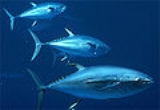
Tuna
Overview
Scombridae
Scombridae is the family of the mackerels, tunas, and bonitos, and thus includes many of the most important and familiar food fishes. The family consists of about 55 species in 15 genera and two subfamilies...
, mostly in the genus Thunnus
Thunnus
Thunnus is a genus of ocean-dwelling fish in the family Scombridae, all of which are tuna, although other tuna species are found in other genera. The name of the genus is the Latinized form of the Greek θύννος, thýnnos, tuna, the word being first mentioned in Homer...
. Tuna are fast swimmers, and some species are capable of speeds of 70 km/h (43.5 mph). Unlike most fish, which have white flesh, the muscle tissue of tuna ranges from pink to dark red. The red coloration derives from myoglobin
Myoglobin
Myoglobin is an iron- and oxygen-binding protein found in the muscle tissue of vertebrates in general and in almost all mammals. It is related to hemoglobin, which is the iron- and oxygen-binding protein in blood, specifically in the red blood cells. The only time myoglobin is found in the...
, an oxygen
Oxygen
Oxygen is the element with atomic number 8 and represented by the symbol O. Its name derives from the Greek roots ὀξύς and -γενής , because at the time of naming, it was mistakenly thought that all acids required oxygen in their composition...
-binding molecule, which tuna express in quantities far higher than most other fish. Some larger tuna species, such as bluefin tuna, display some warm-blooded
Warm-blooded
The term warm-blooded is a colloquial term to describe animal species which have a relatively higher blood temperature, and maintain thermal homeostasis primarily through internal metabolic processes...
adaptations, and can raise their body temperatures above water temperatures by means of muscular activity.
Unanswered Questions

